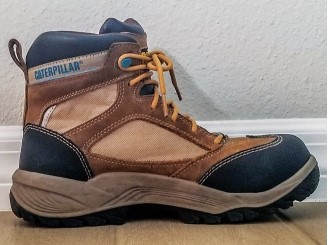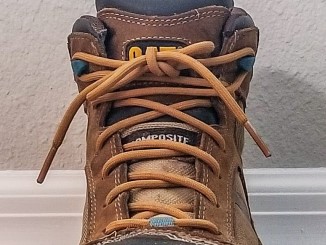Wearing footgear that is the incorrect size for your feet may shorten your career, compromising your back, hips and joints
Editorial note: This is the second in a three-part series in which human and equine chiropractor Patricia Bona explores the significance of proper shoe fit and how to achieve it.
Few professions can compare the physical strength and prowess needed to stay physically sound as a farrier. You bend, lift and twist all day, often with your head at the level of your hips. All the while you are handling and being handled by a sizable animal with a mind of its own and under environmental variables of temperature, footing and lighting, as well as a third person, if you have a handler. The last thing you need is to have your feet weigh you down and trip you up.

A study by the Journal of Foot and Ankle Research in 2018m found that 63 to 72% of the population are wearing the wrong size shoe, most often too short, but also oftentimes too narrow. Odds are high that you are in the 63-70%. But how does this happen?
Many people were misguided to think that they always did and always will fit in size X. This is far from fact. First of all, your feet will invariably change with age: some get flatter and weaker and over-pronate into fallen arches. Or you may have always had a flatter foot or ridged arch. Oftentimes, we lose the vibrancy of the fat pads of the foot as intrinsic muscles atrophy from disuse confinement, which happens when your shoes are too short in length and too small in the toe box to let your toes function as intended.
The second misconception is that you will wear the same size shoe regardless of the style or manufacturer. You will find many variations in how a pair of shoes or boots of the same size fit from manufacturer to manufacturer, as well as different styles offered by the same manufacturer.
As you become a discerning shoe shopper, when you go out to buy some new work boots you will not be surprised to find that the size that fits your foot may change over time and across the brand and style continuum.
FARRIER TAKEAWAYS
- In shoes that fit appropriately, your toes should be free to spread apart to be able to articulate and feel the center of gravity of body to the ground.
- Without propulsion for the foot and ankle (intrinsic foot and calf muscles) you will overuse your hip flexors and compromise your back and hips.
- Proper fitting shoes allow your foot and ankle to function dynamically through all of the ranges of motion.
Understanding Foot Function
There are several considerations when choosing footwear to keep in mind — the most important of which is form and function. We want the form of the shoe to fit the function of your foot and intended activity. Remember, the toes are the fingers to the feet; they are designed to connect our brain to the external world by keeping our eyes level and looking straight ahead, this enables us to be subconsciously aware of our body in space and time — also known as proprioception.

- Give the toes room to move. Shoes that “fit” allow your toes to spread apart to articulate and feel the center of gravity of your body to the ground to aid your righting and postural reflexes, front to back and laterally. The flexion and rotation through your toes allow transfer to forefoot (ball of your foot) and micromanage movement through medial and lateral arches to the calcaneus (your heel). This is where your major calf muscles attach through your Achilles tendon.
- Improper fit affects more than your feet. Your toes need to be able to extend to lift the toe and dorsiflex your ankle to walk without tripping over your toes. Too often a low toe box will deny the ability to flex the ankle and then one’s gait is compromised through the knee up into the hip and back. Without propulsion for the foot and ankle (intrinsic foot and calf muscles) you will overuse your hip flexors, compromising your back and hips. This creates a negative cycle of flat-footed walking, which leads to more tightness and compression to the lower joints and less propulsion and shock absorption in turn causing compression to your spinal facet joints and lumbar discs.
- Beware of tight laces. Besides room in the toe box, your foot needs enough space so that your foot and toes can move. Tight shoe laces will mechanically and neurologically shut down your extensor tensors on the top of your foot and compress your arch. The tendons and the skin have pressure sensory nerves endings as well as proprioceptive, and pain sensory nerve endings. If the body feels restriction caused by the tongue of the shoe due to tight laces, the body will move to a path of less resistance that might avoid moving through the full range of motion to lift the toes up to “break-over.” That can create compromised muscle memory and movement that affects the entire kinetic chain: toes, arch ankle, knee to hip and back. On the other hand, if the body works through the restriction or is numb to it, it can cause a tendonitis or tendiomyopathy in the same way a horse’s leg gets irritated from being bandaged too tight.
The bottom side of the foot is significantly affected by tight laces and can contribute to a fallen arch.
Your foot supports you, and your shoe or boot is its protective bubble. Properly fitting shoes should allow your foot and ankle to freely function dynamically through all the ranges of motion. This means you may need to adjust your idea about what proper fit means. In some cases, this might require getting used to feeling like your shoe is a little loose, when in fact —for the first time — it may be fitting properly.![]()

Dr. Patricia Bona, D.C. is a chiropractor for humans and animals (AVCA Certified since 1994), the co founder of Broad Axe Chiropractic Center and inventor of the Posture Prep Cross Fiber Grooming system for horses. The Blue Bell, Pa., author has also spoken at such events as the International Hoof-Care Summit and Equine Affaire. Visit her at drpatbona.com.
